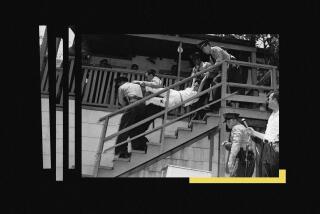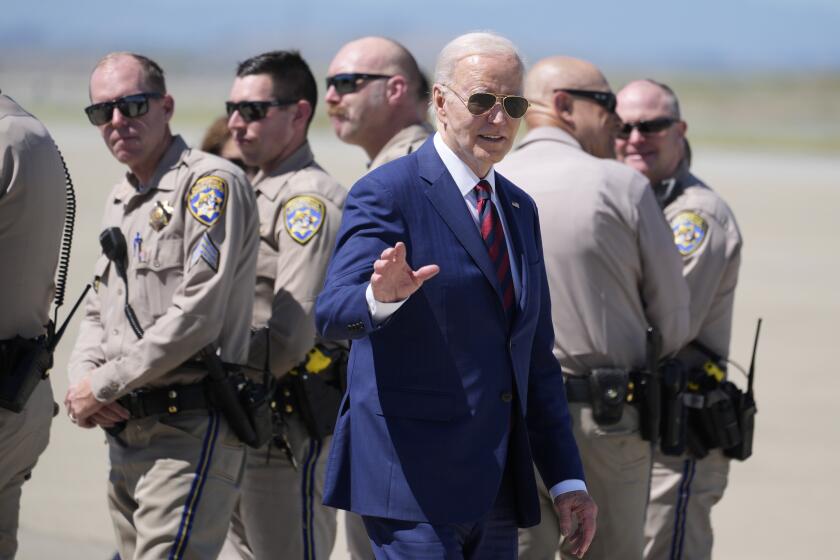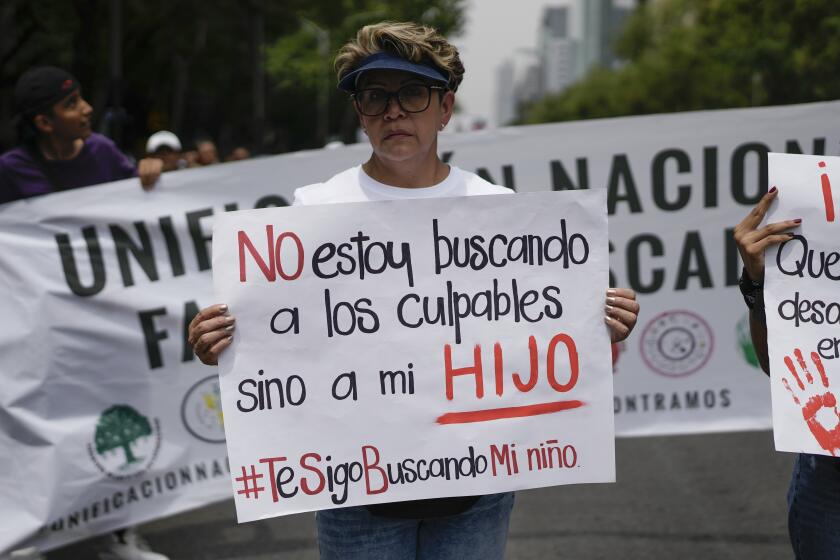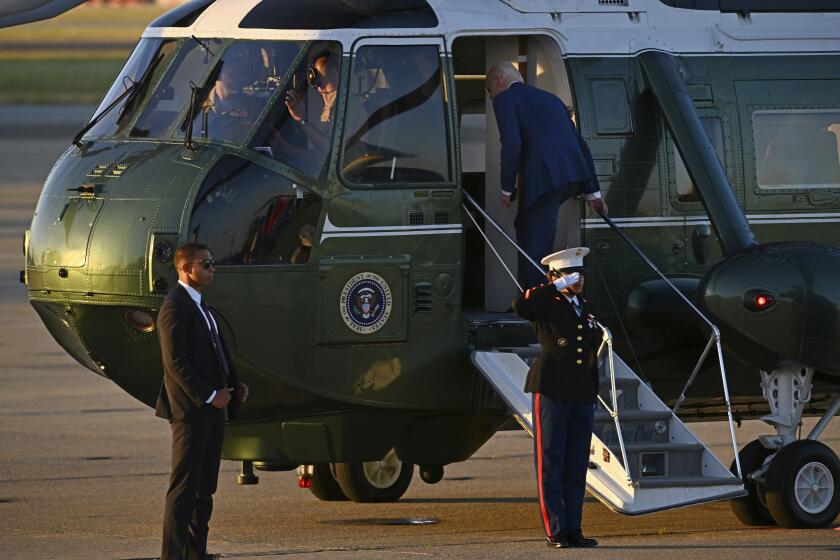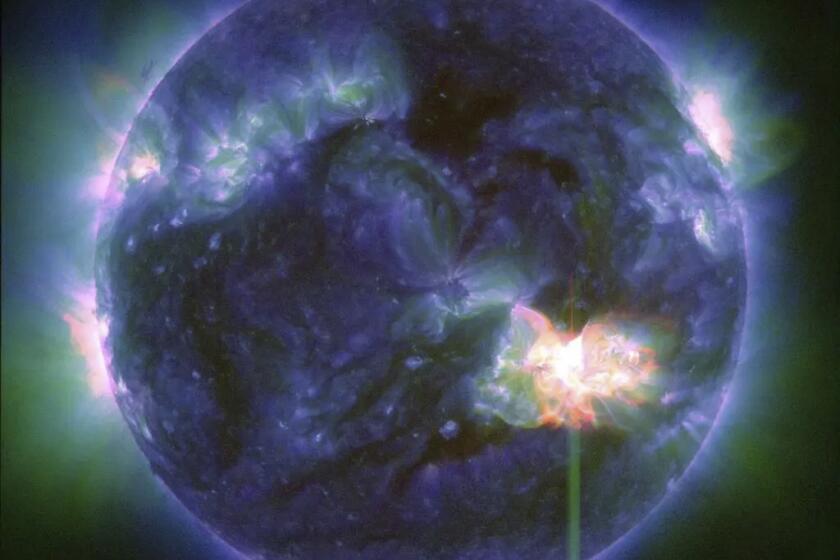A Line in the Sandinista : BLOOD OF BROTHERS; Life and War in Nicaragua, <i> By Stephen Kinzer (G. P. Putnam’s Sons: $24.95; 448 pp.)</i>
For 10 years, now, Washington has been looking for a good fight. To exorcise the infamous demons of Vietnam and Watergate, two American administrations have waged a succession of covert actions, quasi-military crusades and overt wars. They mustered money and guns, organization and training, sometimes putting American lives on the line and American prestige in the balance.
The policy reasons for each conflict differed, but the pattern was roughly the same: There were bad guys out there in the developing world, and Washington was out to get them, whether they were guerrillas, drug runners or government leaders.
The ends often seemed less important than proving that the means could be used. Think of El Salvador, Nicaragua, Afghanistan, Grenada, Lebanon, Libya, Angola and the waters of the Persian Gulf during President Reagan’s terms; Colombia, Panama and Kuwait during the first two years of President Bush’s Administration. Communist enemies gave way to narcotrafficantes and terrorists, before, finally, the Butcher of Baghdad presented himself as the perfect target. Remember Urgent Fury? Prairie Fire? Earnest Will? Just Cause? Perhaps not. There have been so many code names.
Desert Storm is still fresh in the mind, but already the fascination of the Middle Eastern morass is palling for most of the public. As with the crusades of the 1980s, there is a tremendous temptation, now that the main action is over, to turn away. By design or default, American policy tends to perform just as the battlefield missiles soldiers fire and forget.
But as celebrations of the Gulf victory subside and before Americans turn their attention entirely to other issues, it’s worth thinking a little about the aftermaths of our past adventures. In that sense, Stephen Kinzer’s “Blood of Brothers: Life and War in Nicaragua” hardly could come out at a more propitious moment.
More than any of the other conflicts in the last decade, the struggle for Nicaragua was a contest in which the Administration seemed sure of the good guys and the bad guys, while on the ground it was almost impossible to tell the difference. Few correspondents spent more time in that volcanic country than Kinzer: 12 years, on and off, five of them as the New York Times bureau chief in Managua. Few knew the players more intimately or saw the tragedy more clearly.
The Reagan Administration created the war in Nicaragua, although it never sent its own troops into the field. Its aim was to eliminate a newly established Marxist government in the Americas. It assembled, supplied, indoctrinated, underwrote and protected the army of dissidents and exiles that came to be known as “the Contras.” It dissembled about its purpose. “We are not doing anything to try and overthrow the Nicaraguan government,” President Reagan would proclaim.
The objective, repeated ad nauseum and absurdum in the formative years of the conflict was simply to keep the Sandinistas from backing rebels in nearby El Salvador. It was, as Kinzer puts it, “an argument no sentient observer could honestly have believed.” But Congress, however reluctantly, went along with the charade through most of the ‘80s.
Much has been written about those early years, often with more detail, sometimes with more drama than Kinzer lends to the story. His book is constructed as a personal odyssey, a narrative fashion much favored by editors these days, to which his personal style and passionless prose are not well adapted. There is more than even a journalism student would want to know about the ways in which he built his career from free-lance stringer to bureau chief. An entire chapter devoted to the sleuthing out of a little Contra camp in Honduras concludes: “What I found was big news, but it did not tell much about Nicaragua.” Indeed.
The later chapters do tell quite a bit, however, about the consequences of the war. After the saturation coverage that accompanied the Iran-Contra scandal in 1986-1987, little international interest focused on Nicaragua. Yet by 1988, Kinzer writes, “the signs of devastation were everywhere.” Inflation was running at an annual rate of 30,000%. “At the city’s fetid garbage dumps, poor people scavenged like rats for scraps of food. When the health ministry surveyed 2,829 randomly selected schoolchildren, it found 75% of them suffering from malnutrition.” A wild rumor spread that the Canadian government was sending a ship to pick up would-be emigrants. “Whole families, in some cases even whole villages, packed their miserable belongings into burlap sacks” and made their way to the port.
When the Sandinistas finally decided to hold genuinely free elections, they were voted out of office. Amazingly, they went, and their old adversaries in Washington were quick to claim credit.
Kinzer wouldn’t give it to them. The contras were by then a vanquished army, he writes. “Most Contra foot soldiers had withdrawn to camps in Honduras, where they were living off handouts from the United States. No one could doubt that the Sandinistas had defeated them.”
Nor did the Sandinistas’ decision to step down have much to do, in the end, with Washington’s demands. The demise of communism in Eastern Europe and the Soviet leadership’s loss of interest in world revolution effectively left them alone in the world, rethinking their dreams. Unlike their longtime ally, Fidel Castro, they adjusted quickly.
Kinzer rightly condemns the arrogance and the many failures of Nicaragua’s revolutionaries. But in a conclusion that many American readers may find unsettling, he praises the revolution itself. In the rest of the region, Kinzer notes, the status quo has been preserved through the force of American aid, military advice and other less savory means. The wars in El Salvador and Guatemala sputter on, Honduras is a wreck, but the presence of figurehead civilian presidents long ago gave the United States an excuse to declare victory and turn its eyes away.
“The old elite was able to retain all of its privileges,” writes Kinzer. “Armies which had brutalized their populations and kept them in misery for generations remained intact, and political fanatics who directed death squads and other forms of violent repression continued to act with impunity. By no honest standard could these countries be considered democracies, nor was there any real prospect that they could evolve toward democracy.”
Nicaragua is potentially in better political shape than its neighbors, says Kinzer, but no thanks to Washington. “By destroying the repressive apparatus of the Somoza family (the traditional U.S.-supported dictatorship that preceded them), the Sandinistas at least provided a basis on which a genuine democracy could be built. They made it possible for Nicaraguans to go peacefully to the polls and choose the kind of government they wanted. . . . Had they done nothing more than that, they would deserve a place of historic honor.”
Carl von Clausewitz, the 19th-Century Prussian strategist, once said that “No one starts a war--or rather, no one in his right senses should do so--without being clear in his mind what he intends to achieve by that war and how he intends to conduct it.” The most consistent aim of America’s wars for the last decade has been to prove, simply, that they could be fought.
Perhaps now that the Vietnam demons have been declared vanquished, along with Saddam Hussein, Washington will feel less need to assert American potency through covert and overt violence. If it considers the toll that its wars have taken on the countries where they’ve been waged, re-thinks who really won, who lost, and why, it could even find some keys to the new world order that President Bush says he’s looking for.
More to Read
Start your day right
Sign up for Essential California for news, features and recommendations from the L.A. Times and beyond in your inbox six days a week.
You may occasionally receive promotional content from the Los Angeles Times.


